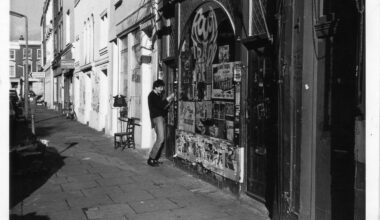Do constraints breed creativity? The Horrors’ Tom Furse was determined to find out so off he went on a sonic journey with just Teenage Engineering’s OP-1 for company…
Restrictions and constraints can frequently draw the best out of a situation. Consider French writer Georges Perec who wrote the novel ‘La Disparition’ (‘The Disappearance’) in 1969, all without using the letter “e”, or Matthew Herbert who has made a career out of his strictly constrained means of production, building tracks entirely out of recordings of crisp packets, a shoe, or the human body.
Attacking this idea from another angle, Tom Furse, keyboardist for shoegazing band The Horrors, chose to escape the comfort and convenience of Ableton Live on the computer screen to explore the quirky charms of the OP-1 synthesiser from playful Swedish mavericks, Teenage Engineering. The result is ‘Interludes’, an entire album created exclusively on the OP-1 and put together in just one week.
For those of a certain generation, the OP-1 prompts memories of the classic white plastic Casio VL-Tone. This 80s keyboard, which couldn’t choose between being a micro synth, a sequencer and calculator, featured a tiny keyboard that even a hamster would have struggled to play. Cheap and enticingly cheerful, it could be heard on The Human League’s ‘Dare’, Trio’s numbingly catchy ‘Da Da Da’, and most amusingly on The Fall’s ‘The Man Whose Head Expanded’, only to be switched off by Mark E Smith’s command to “turn that bloody blimey space invader off”.
Undoubtedly Teenage Engineering intended the OP-1 to arouse suspicion of such resemblances and I was curious to hear why Furse chose to focus on this singular machine.
“To be honest, at first it didn’t seem very appealing at all,” he offers. “It was digital, something that I wasn’t interested in at the time and it was very expensive, although it looked great and I had heard a few interesting demos. Then I borrowed one from my brother to get know how to use this thing, and I thought I’d do some short interludes for a show I do on NTS Radio. The more I began to play with it, the more I realised that it’s an intuitive machine with a lot of scope.”
In the manner of Doctor Who’s TARDIS, where the exterior and interior exist in separate dimensions, seemingly infinite in size, the OP-1 hides a wealth of capability behind its modest good looks. Featuring nine varieties of synthesiser engines, five unique sequencers, drums, effects, a four-track, tape-style recorder, a sampler, basic mastering capabilities and even an FM radio, which was a source of great inspiration to Furse.
“‘No-One Cries No More’ is pretty much just me scanning through the radio,” he explains. “I found a loop that I liked and wanted to mess around with the speed adjustments, the tape wobble and so on. I used the built-in radio quite a bit on the album, especially on the lo-fi stuff as the reception wasn’t that great. I live in an area that has a big Turkish community so there was a lot of Turkish radio and Classic FM broadcasting loud and clear. As a sample source Classic FM was great as it’s almost always an orchestra with very little rhythm, and so the samples are actually very easy to manipulate.”
Drawing sounds from the ether and pulling these signals into the OP-1 means that the album applies influences from the most unexpected places. It sometimes feels as if the listener is boarding a bus with a mystery destination, taking an exotic journey across Ethiopia submerged in a halo of melodic overtones, through hotel lobbies with lulling, lilting lounge music, into imaginary rehearsal rooms where The Muppets’ drummer Animal offers up a cymbal solo over an arching bassline and uncompromising strings, and ends up in a blurry nightclub with ‘A Change Of Direction’, as robust synths urgently charge through the doors and pulsing cloudheads of noise devour you.

The restrictions of the OP-1 are evident in the recordings, and I was curious to learn how much of what we are hearing is the machine itself, assuming control of the whole creative process.
“It really informed it,” says Furse. “I’m interested in the point between music and technology and how they feedback on each other and how technology can be really influential in making music. Machines are very influential, whether it’s an 808 or a modular. Any innovative piece of equipment tends to influence what you create with it. There’s obviously a matter of spectrum within that of course, but I found the limitations interesting. You just accept that you can’t have a complex arrangement.”
Constraining a learned creative process within such boundaries could prove to be a challenge though, right?
“It was something I accepted quite quickly,” he says. “My biggest surprise was that the sequencer runs on its own clock. There’s a master tempo that isn’t linked, so for someone like me who loves sequencers it was like, ‘Oh, you have to get on with these limitations’. Initially it was just interludes, minute-long pieces of music, but that then snowballed into making an album. Essentially you are learning how to work with a four-track cassette interface.”
Intriguingly there’s a visual component that accompanies the release, echoing the musical process.
“I kind of did a repeat of my naïve experiment with the OP-1, but with video synthesisers and video manipulation,” he explains. “I’d always wanted a visual accompaniment, but getting someone to make 45 minutes of visuals was hard to find with such a responsibility, and no budget! So I thought, ‘Why don’t I do it myself?’. I found some apps and programs and did the whole thing for free and loved it. I really enjoy these sort of little experiments, there’s something really exciting about the challenge.”
A sense of innocent discovery pervades the album, as what you are hearing is capturing this very moment of revelation. Without the luxury of careful editing, this meant getting it right first time or starting again all over. All of which is a far cry from Furse’s previous decade of experience using software.
Therein lies the joy of constraints. With too many options we can easily dilute our energies and flitter about, failing to focus on the task at hand. Indeed, this applies to all areas of our life. Creating or working within boundaries can be both empowering and inspiring.
Maybe we could all learn a lesson from American writer Ernest Hemingway, whose economical style of writing had an immense influence on 20th century fiction. Challenged by his friends to write a story in just six words, Hemingway rose to the occasion with dignity.
With such extreme limitations he needed to craft the tale to encapsulate characters and their relationships and delivered the most potent micro-drama in just six words: “For sale: baby shoes, never worn”.
‘Interludes’ is out on Kaya Kaya/Mind Meld






